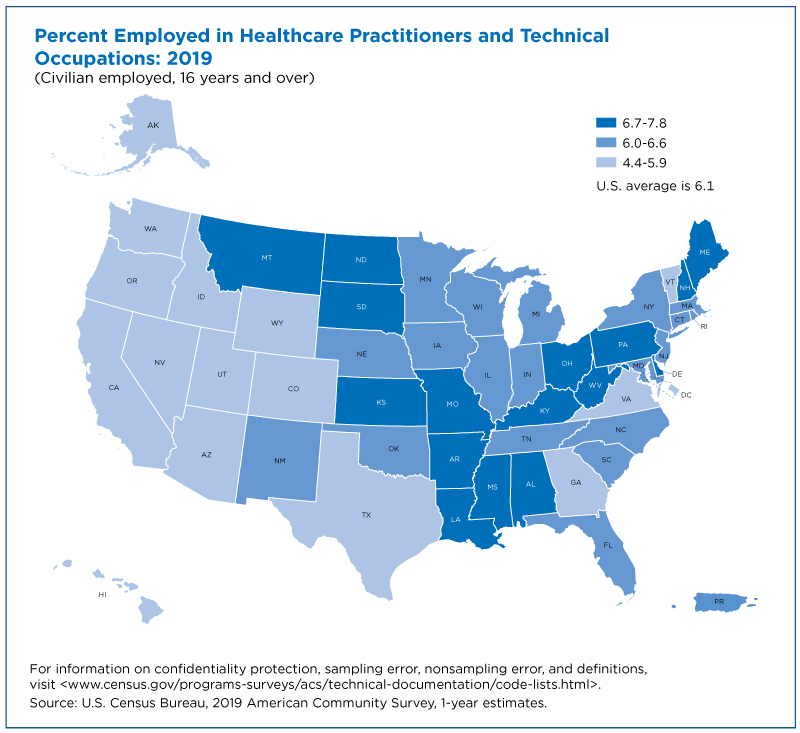22 Million Employed in Health Care Fight Against COVID-19
Many of the nation’s health care workers are now on the front line of the battle with COVID-19. Who are these people putting their lives at risk daily to care for the millions who have contracted the coronavirus?
There were 22 million workers in the health care industry, one of the largest and fastest-growing sectors in the United States that accounts for 14% of all U.S. workers, according to the Census Bureau’s 2019 American Community Survey (ACS).
There were 9.8 million workers employed as health care technicians and practitioners, including physicians, surgeons, and registered nurses.
The health care and social assistance industry sector includes establishments that provide medical care in hospitals, clinics and doctor’s offices, nursing and residential care, and social assistance such as family and childcare services.
In 2019, around seven million people worked at general medical, surgical or specialty hospitals; some two million at outpatient care centers and about 1.8 million worked at nursing care facilities.
Health Care Occupations
There were 9.8 million workers employed as health care technicians and practitioners, including physicians, surgeons, and registered nurses. About two-thirds were non-Hispanic White.
Another 5.3 million worked as nursing assistants, home health and personal care aides and in other health care support occupations. One-quarter of health care support workers were Black.
Women accounted for three-quarters of full-time, year-round health care workers.
Women working as registered nurses, the most common health care occupation for women, had median annual earnings of $68,509.
In contrast, women working as nursing assistants, the most common health care support occupation, earned $28,686.
Among full-time, year-round health care workers, more than half of paramedics, surgeons, and other physicians were men. Median earnings for men in selected health care occupations ranged from under $30,000 for home health aides to over $250,000 for emergency medicine physicians.
Health Care Workers by State
States with over 500,000 health care practitioners and technicians include California, Florida, New York, and Texas. However, the overall distribution of health care related workers varied by state.
For example, there were about six health care practitioners and technicians per 100 civilian-employed workers ages 16 and over in the United States.
While about 58,000 workers in West Virginia were health care practitioners and technicians, they accounted for nearly 8 out of 100 of the state’s workers ages 16 and over. In the District of Columbia, 4 out 100 workers, or just over 17,000, worked as health care practitioners.
The number and distribution of health care support workers also varies across the United States.
California had 718,011 health care support workers — the largest number of any state — accounting for about 4 out of 100 workers in the state.
In contrast, nearly 5 out 100 workers (454,514) in New York had health care support jobs. Nearly 2 out 100 workers (just over 23,000) in Puerto Rico worked in a health care support occupation.
We used statistics from the 2019 American Community Survey to profile health care workers at the national and state level.
Data.census.gov provides selected labor force statistics. ACS estimates are based on data from a sample of housing units and people. Therefore, respondents may or may not live and work in the same geographic location as their employer.
Additional information on industry and occupational classifications is available from the Industry and Occupation Statistics Branch.
Story Ideas and Statistics
-
Stats for StoriesNational Nurses Day and Week: May 6 and May 6-12, 2023The 2021 American Community Survey estimated 2,535,581 registered nurses, 825,238 nursing assistants, and 423,489 licensed practical and vocational nurses.
-
Stats for StoriesNational Women Physician Day: February 3, 2024According to the 2021 American Community Survey, there were 272,196 women physicians. Full-time earnings were $185,183.
-
Stats for StoriesNational Doctors Day: March 30, 2024The American Community Survey estimates there were 733,169 civilians 16 years and over employed as “Other physicians” in 2022. Median earnings were $234,274.
Subscribe
Our email newsletter is sent out on the day we publish a story. Get an alert directly in your inbox to read, share and blog about our newest stories.
Contact our Public Information Office for media inquiries or interviews.
-
America Counts StoryHealth Care Still Largest U.S. EmployerOctober 14, 2020The 2018 County Business Patterns show that health care employs the most but Professional, Scientific, and Technical Services saw the largest payroll increase.
-
America Counts StoryYour Health Care Is in Women’s HandsAugust 14, 2019Since 2000, women’s participation and median earnings in high-education health care jobs are up while earnings in other health care jobs show little gains.
-
America Counts Story2020 Census Results Inform Funding for Hospitals and Health CareJuly 13, 2020Census data inform health care programs that touch everyone from the old to the young, people of all incomes and backgrounds in cities, suburbs and rural areas.
-
PopulationTribal Casinos: An Economic BoonNovember 20, 2025A new study explores how tribal casino expansion in the 1990s and 2000s affected poverty, jobs and income for American Indian communities and their neighbors.
-
NAICS Sector 31-33 ManufacturingSome Less Populous States Have High Manufacturing Revenue Per CapitaSeptember 29, 2025Today is the start of a week of celebrations at the Census Bureau marking the 14th annual Manufacturing Day on October 3.
-
Families and Living ArrangementsCouples’ Finances: Married but SeparateSeptember 24, 2025While most married couples had joint bank accounts, fewer shared all their financial accounts.
-
FertilityChildlessness on the Rise — Except for Women Ages 45 to 50September 23, 2025From 2014 to 2024, the share of older mothers rose as fewer teens and women in their 20s and 30s had children.









